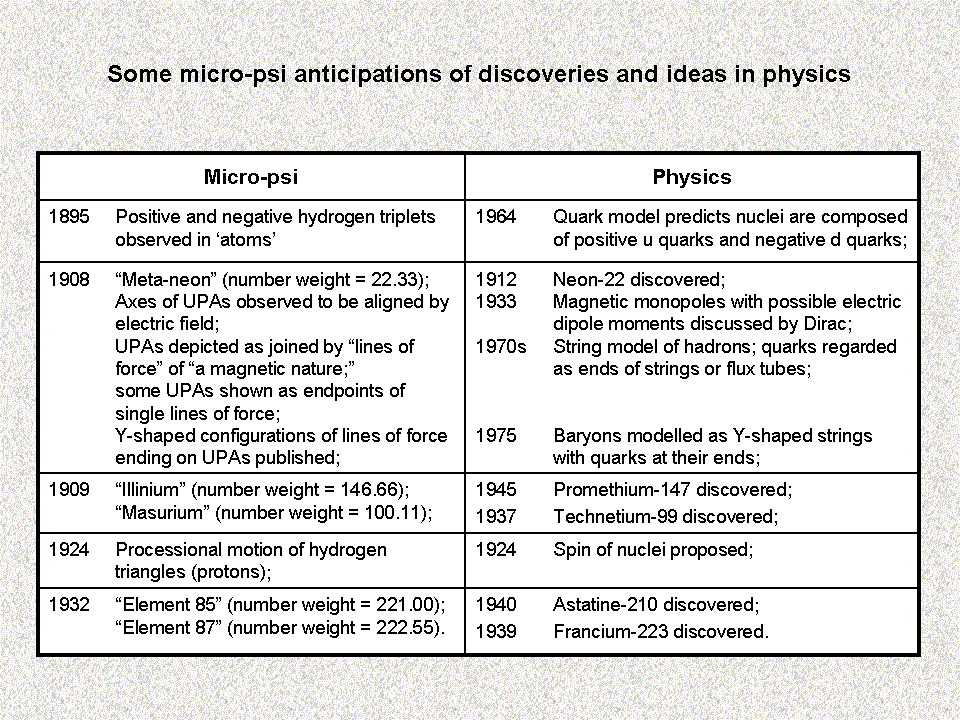| << Previous 1... 7 8 [9] 10 11 ...13 Next >> |

The table compares observations and discoveries made with micro-psi by Besant & Leadbeater with corresponding discoveries in nuclear and particle physics decades later.
The processional motion (wobble) of hydrogen triangles was described in 1924 (The Theosophist, vol. 45) during a study of the hydroxyl group (atoms of hydrogen and oxygen bonded together) in the water molecule: It was said: "Each triangle rotates flat, and whilst rotating. sways a little up and down, as the lid of a pot rotates before it finally settles down" (Occult Chemistry, 3rd ed., p. 206). This is a description of Larmor precession, for the hydrogen triangles are protons endowed with a spin and a magnetic dipole moment (i.e., they are like a bar magnet, which aligns itself to a magnetic field). The remarkable significance of this is that Besant & Leadbeater described the spin precession of a proton in a magnetic field a year before George Uhlenbeck and Samuel Goudsmit introduced the concept of 'electron spin,' which posits an intrinsic rotational angular momentum for this particle. The observation was made therefore before the proton was realised to possess a spin as well! Neither Besant & Leadbeater nor physicists could have known in 1924 that some electrically charged subatomic particles have an intrinsic spin that endows them with an intrinsic magnetic moment, causing them to wobble in a magnetic field. Here is clear and undeniable evidence of the objective nature of their micro-psi visions.
It was described earlier how the MPA of a second species of the inert gas neon with a number weight of 22.33 was described in 1908 by Besant & Leadbeater, about four years before the experimental physicist Francis Aston separated the neon-20 and neon-22 isotopes with his new mass spectrograph, although at the time he thought wrongly that he had discovered a new element. Aston, of course, got the scientific credit, winning the Nobel Prize in Chemistry in 1922. But, despite their error in assuming that they had paranormally observed atoms, Besant & Leadbeater were the first people to discover that neon had two forms, even publishing a number weight of 22.33 that was appropriate for the Ne-22 isotope. The fact that it was not a scientifically-made discovery does not invalidate their priority in the matter. Besant & Leadbeater did not call them "isotopes," always using the terms "meta" and "proto" for what turned out to be isotopic variations in MPAs, because it would be 1913 (five years later) before the English chemist Frederick Soddy coined* this word for atoms of an element that differ in mass, although strong suspicions of their existence had developed in 1912 in Aston's study of radioactivity. When Robert Matthews reported in 2003 in the British national newspaper The Daily Telegraph on scientific historian Dr Jeff Hughes' discovery of Aston's plagiarism over the Theosophists' term 'meta-neon,' he, predictably, dismissed as coincidence how they managed to notice and then publish a variation of neon that had a number weight within one per cent of Aston's measurement four years later, using his mass spectrograph, of the atomic mass of Ne-22. Some coincidence! But, then, he would probably have said the same about every other example of their remarkable, clairvoyant anticipation of scientific discoveries if he had first bothered to acquaint himself with Occult Chemistry before prejudging their work as "non-rational." Supposing that he did read their book, he should now ask himself whether his equally vacuous and prejudiced dismissal of all these examples as yet more coincidences can be called "rational." Perhaps he might realise what (or who) is more non-rational here — namely, anyone who persists with an ideological bias towards evidence of paranormal abilities despite overwhelming evidence that supports a particular example of them.
*The term was suggested to Soddy by Margaret Todd, a Scottish doctor and writer.
| << Previous 1... 7 8 [9] 10 11 ...13 Next >> |